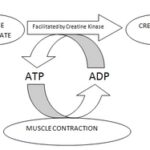Nucleotides are a specific type of molecule that plays an important role in the development and maintenance of RNA and DNA in the body. Nucleotides are essential to life. Nucleotides, aside from being present in both RNA and DNA are involved in the enzyme reactions in the body, the production of chemical energy, and the signals transmitted between cells.
Each nucleotide consists of three substances; a base, a sugar (monosaccharide) and a phosphate. The bases found in DNA and RNA include adenine (A), cytosine (C), guanine (G), thymine (T), and uracil (U). Three of these bases, adenine, guanine and cytosine are found in both DNA and RNA. Uracil (U), however, is only found in RNA and thymine (T) is only found in DNA.
Adenosine Triphosphate (ATP)
Adenosine triphosphate is a high-energy molecule found in the body that provides the energy used and expended in everything the body does. ATP is manufactured within the organelles of the cell known as mitochondria, and stores energy from exergonic reactions and then releases it only moments later in order to allow the body to perform some kind of physical work. ATP plays a key role in the synthesis of proteins, cell movement and cell division.
One example of a reaction in which ATP obtains it’s energy from would include glucose oxidation. The first thing that occurs is glycosis, a process in which the sugars are split. If pyruvic acid, a chemical used to provide energy to the body, is present, it is then converted to lactic acid using anabolic fermentation. Anabolic fermentation is not the best route in order to obtain energy because it is inefficient, and can be toxic to cells. If oxygen is available, a more effective method can be utilized to obtain energy; aerobic respiration. In aerobic respiration, the pyruvic acid is broken down and can generate up to 36 molecules of ATP for each of the previous glucose molecules.
Other Nucleotides
Guanosine triphosphate (GTP) is found within the RNA to form the guanylic acid units. GTP is involved in rapid energy transfers and is known to “donate” phosphate groups to other molecules.
Nucleic Acids
Nucleic acids are polymers (long chains) of nucleotides. DNA is a nucleic acid that is commonly found to be between 100 million and 1 billion nucleotides long. The DNA contains all of the genetic coding of the body, from hair and eye color, to nose shape and any genetic predisposition to diseases or conditions. This information is then passed on to offspring when the being reproduces. DNA is often thought of as the “blueprint” for the body.
RNA are another form of nucleic acid, commonly found to be between 70 to 10,000 nucleotides long. RNA is responsible for carrying out and assembling the “blueprints” found in the DNA. In other words, RNA is responsible for the reading and administration of the instructions found in the DNA.
References
Saladin. “Major Themes of Anatomy and Physiology.” Anatomy & Physiology: The Unity of Form & Function. 4th ed. New York: Mcgraw Hill, 2007. 82, 83, 84, 85 Print.
Nucleotides
What are Nucleotides?
What is Pyruvic Acid?
Adenosine Triphosphate
Guanosine triphosphate





